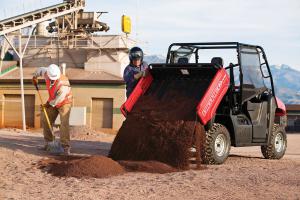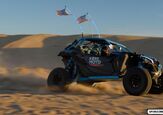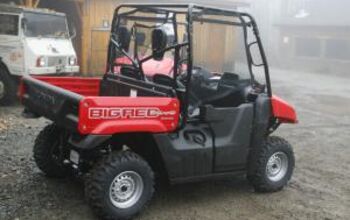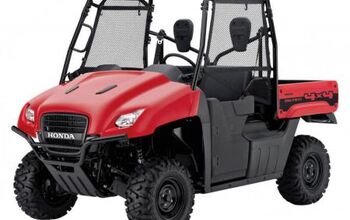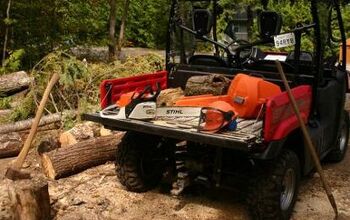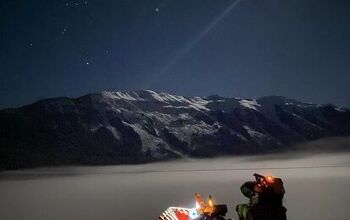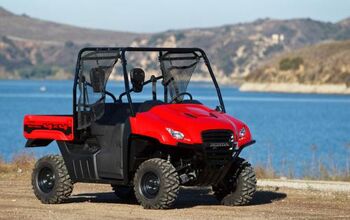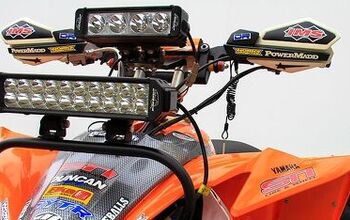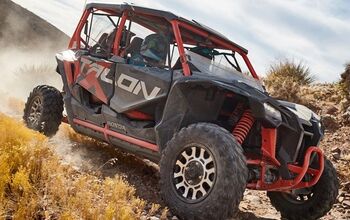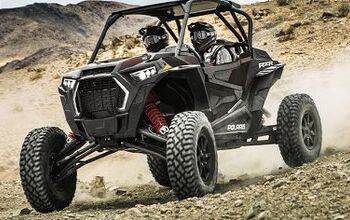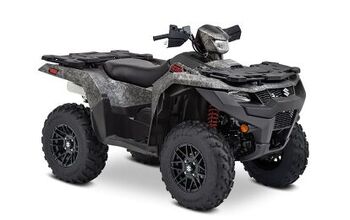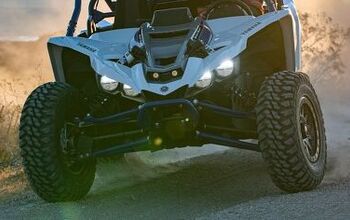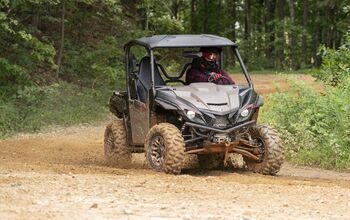2009 Honda Big Red Preview
With Yamaha, Polaris, Kawasaki and Arctic Cat already on board and Can-Am rumored to be coming along; it was only a matter of time before Honda joined the side-by-side revolution. Enter the 2009 Big Red.
Honda has been teasing the Big Red for months and the utility-minded side-by-side has finally been released.
According to Honda, what sets the Big Red apart from the competition is the focus on convenience features.
The Big Red’s cab features rubber-mounted seats with adjustable backs designed to comfortably fit a wide range of body types while also reducing fatigue on long drives. Each seat is equipped with three-point Emergency Locking Retractor (ELR) seat belts, which are similar to automotive type belt systems. To keep debris at bay, the belt deploys from a housing that features a narrow topside slot. The bottom has a port that Honda says will allow debris to exit so it doesn’t accumulate in the belt housing.
Honda’s Big Red is a ‘work-first’ vehicle, but it has some play in it.
Adding to the convenience factor is a waterproof accessory socket located between the bucket seats for access to 12-volt power, a glove box and dash storage.
To help minimize maintenance, the Big Red is equipped with a maintenance–free battery and shaft final drive. Also, Honda engineers placed the engine oil-filler and dipstick under the driver’s seat. Access to the air filter is as easy as lifting the tilt-bed, which reveals the air filter box.
Enough with the periphery, it’s time to get down to the guts of the Big Red. Honda’s side-by-side is powered by a 4-stroke liquid-cooled fuel-injected 675cc engine that feeds power to the wheels through a three-speed automatic transmission. This big-bore single-cylinder powerplant features a bore and stroke of 102mm x 82.6mm. The camshaft is located adjacent to the cylinder head and pushrods are used to actuate the valves, which Honda says was done to reduce engine height, lower the center of gravity and enhance handling.
Honda says the liquid-cooled oil cooler helps heat dispersion in the engine. Because the liquid warms quicker than engine oil, it also helps warm up the engine quicker on cold days. Additionally, the radiator is mounted up high behind the front grill where mud is less likely to clog the fins.
The engine is placed right between the driver and passenger.
Honda’s programmed fuel injection system (PGM-FI) is key to the engine’s performance. The Big Red’s PGM-FI uses a 40mm throttle body and a 12-hole fuel injector to maximize fuel atomization.
At 64-inches wide, the Big Red should be plenty stable on the trails.
Essentially, this system monitors several variables to control the injected fuel quantity. PGM-FI is a mapped injection system, meaning that the basic variables of engine speed and throttle angle are used to determine mapping. Based mainly on those measurements, the system looks to the Electronic Control Module (ECM) for precise fuel delivery. The ECM adjusts fuel delivery according to four additional variables: intake-port pressure, engine coolant temperature, intake-air temperature and atmospheric pressure. This fuel-delivery recalculation process is repeated many times per second to ensure the correct mixture for conditions. Honda says it provides optimal performance and crisp throttle response over a wide operating range.
When it comes to shifting gears, Honda has incorporated what it calls an automotive-style transmission. This system features a hydraulic torque converter, three hydraulic clutches and an ECM to automatically select one of three forward gears. Reverse also comes standard.
The torque converter used in this system operates in principle much like the torque converters used in trucks and automobiles. It links the engine to the automatic transmission similar to the way a manual clutch connects an engine to a manual gearbox. Both systems drive the vehicle and they also come into play when the vehicle stops.
A final shaft drive is also incorporated into the Big Red. Honda says that combined with the three-speed automatic transmission, the final shaft drive provides positive engine braking that is superior to some electronic braking systems.
A dash-mounted drive selector lets the driver choose between drive modes. 2WD with open rear differential is meant for sensitive terrain and lawns, 4WD with rear differential and 4WD with all-wheel differential lock.
When it comes to the chassis, the suspension system provides 10.3 inches of ground clearance. Independent double-wishbone front and rear suspension features variable-damping shocks for 5.9 inches of travel in front and 7.1 inches in the rear. Stability should be enhanced by the Big Red’s 64-inch width.
Stopping power comes courtesy of four-wheel hydraulic disc brakes. Honda says the brakes provide predictable stopping power with a progressive feeling. They also feature a balanced automotive-style design that, according to Honda, ensures front and rear braking even in the event that one brake line fails for some unexpected reason.
The automotive style right-hand-operated parking brake actuates the two rear-wheel brake calipers. Honda says since these brakes employ hydraulic actuation, no parking brake adjustments need ever be made to compensate for parking-brake wear.
All four wheels are the same 25 x 10-12 inch size so you only need to carry one size spare during extreme use.
With utility in mind, the Big Red comes with a steel-framed tilt bed measuring 33.0 by 52.6 by 10.3 inches and the ability to carry 500 pounds. The bed is covered in a molded polypropylene top plate with no wheel-well intrusions. Honda says a standard cargo pallet will fit flat with room to spare. Honda says the 6.5mm-thick top plate won’t rust and features rounded corners for easy cleanup, and four D-rings for securing cargo. A tilt-release handle is located on both left and right sides, while the progressive action strut assist system, according to Honda, makes raising and lowering the bed easy to do.
A two-inch receiver-style hitch can tow up to 1,200 pounds and its multi-reflector headlight system and LED brake light and taillight provide ample illumination.
A quick look at the specs list shows the Big Red has no digital instrumentation, but it is available for an additional $200. A winch, windscreen, roof, A-arm guards, storage box and a host of other accessories are also available.
Purchasing the Big Red will set you back $11,399, which is between $500-$700 more than the 2009 Kawasaki Teryx 750 FI 4×4, Yamaha Rhino 700 FI Auto 4×4, Polaris Ranger XP and Polaris Ranger RZR.
ATV.com should have a full review of the Big Red in the coming months and we’ll tell you how it compares to the rest of the side-by-sides out there.
| 2009 Honda Big Red Specs | |
| Engine: | 675cc liquid-cooled OHV single-cylinder four-stroke |
| Bore x Stroke: | 102.0 x 82.6 mm |
| Compression Ratio: | 9.2:1 |
| Induction: | Electronic fuel injection (PGM-FI), 40mm throttle body |
| Ignition: | CD with electronic advance |
| Starter: | Electric |
| Clutch: | Automatic |
| Transmission: | Automotive-style with hydraulic torque converter, three forward gears and Reverse and three drive modes including: 2WD, 4WD and 4WD with all-wheel differential lock |
| Driveline: | Direct front and rear driveshafts |
| Front Suspension: | Independent double-wishbone; 5.9 inches travel |
| Rear Suspension: | Independent double-wishbone; 7.1 inches travel |
| Front Brakes: | 200mm hydraulic disc with 51.1mm caliper |
| Rear Brake: | 200mm hydraulic disc with 30.3mm caliper |
| Front Tires: | 25 x 10-12 |
| Rear Tires: | 25 x 10-12 |
| Length/Width/Height: | 114.7 x 64.0 x 76.9 in |
| Curb Weight: | 1,431 lbs |
| Wheelbase: | 75.7 in |
| Ground Clearance: | 10.3 in |
| Fuel Capacity: | 7.9 US gal. |
| Turning Radius: | 13.8 feet |
| Cargo Bed Capacity: | 500 lbs |
| Towing Capacity: | 1,200 lbs |
| Colors: | Red, Natural Gear Camouflage |
| Base MSRP: | $11,399 |
More by ATV.com Staff



